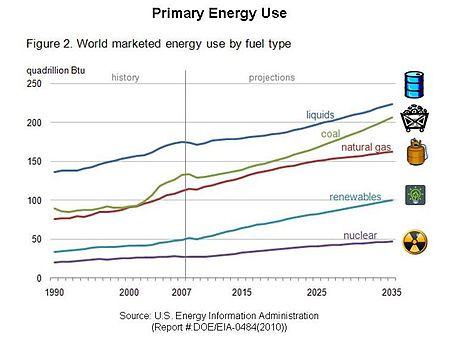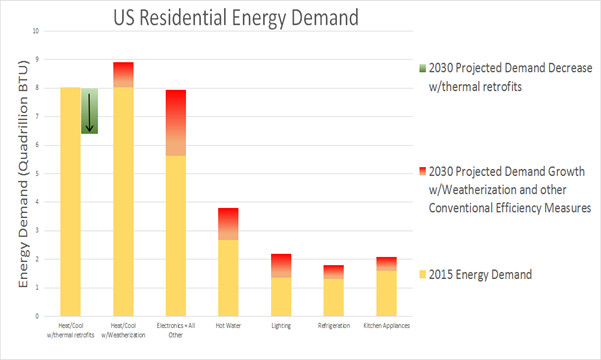 Hardly affected by growing support for decarbonizing the energy system, fossil fuels are expected to continue dominating global energy.
Hardly affected by growing support for decarbonizing the energy system, fossil fuels are expected to continue dominating global energy.
Natural gas has not reset the carbon trajectory. In the US, carbon dioxide emissions from burning natural gas have surpassed those from burning coal. EIA expects no relief: world energy consumption is expected to grow from 549 quadrillion Btu in 2012 to 815 quadrillion Btu in 2040.
McKinsey projects that energy-related greenhouse gas emissions will rise 14 percent in the next 20 years.
The New York Times drew attention to the decarbonizing challenge: “Even with the impressive recent gains for renewable energy, the world is still far from solving global warming……One reason: carbon-free sources like wind, solar and nuclear power aren’t yet growing fast enough to keep up with rising global energy demand…….global coal consumption could stay flat for decades……the average coal plant in Asia is less than 15 years old (compared to about 41 years in the United States)”.
The 1980 USDOE report (DOE/PE-0020), “Low Energy Futures for the United States” painted a cheery picture, where “efficiency improvements provide primary fuel savings that more than offset the growth in the demand for energy services”. To move toward this system-balanced future, efficiency programs were established across the US in the 1980’s. Despite significant funding, these programs have never produced enough efficiency to offset demand growth.
Recently, regulatory economist Kenneth W. Costello summarized long-standing equity concerns about US efficiency program benefits. Another concern is the limited attention given to space conditioning energy, primarily supplied by fossil fuels.
Renewable energy is the most visible option for decarbonizing the energy system, as it claims a steadily increasing percentage of new electricity generating capacity. Solar and wind farms are becoming larger and more common. Rooftop solar is growing sharply as global competition drives cost down. Despite this popularity, solar and wind supply less than 4% of the world’s energy. Drawn to the photogenic success, many are not aware of the 2017 reminder from Solar Daily: “expansion of renewable energy cannot by itself stave off catastrophic climate change”.
The need to go beyond renewable energy points to the less glamorous task of decarbonizing the energy used for maintaining comfort in homes.
 Infra Red Photo
Infra Red Photo
Most interior space is surrounded by thermal defects such as lumber, pipes, electrical boxes, ducts, doors and windows. This is like wearing a flannel shirt when you need a parka. Thermal leakage has become an accepted feature in the residential sector. Once the thermostat is set, few think about the effectiveness of their home’s thermal shell.
Fortunately, most thermal leakage can be eliminated by local contractors using commercially available products. Thermal retrofits offer a painless and direct approach to decarbonization.
A continuous thermal seal permanently reduces a home’s propensity to consume space conditioning energy. Unlike other types of efficiency, the effectiveness of thermal efficiency can be measured with performance scoring systems.
One such system is the RESNET HERS index, which has been used for post-construction evaluation on more than 2 million homes. With HERS, demand reduction can be monetized over the life of the home. At the right price, energy suppliers can find enough value to invest in thermal retrofits.
Despite hundreds of US efficiency programs, every type of residential demand is projected to rise. The ability to measure the impact of a thermal retrofit creates a mechanism to change the trend of heat/cool consumption.

Improved comfort and resilience add value to good thermal performance. Details about optimized thermal performance are in this 2016 Climate Institute report.
With unemployment soaring and the public sector over-stretched, utilities should consider an option to buy demand reduction from local contractors rather than more energy. By rethinking this pattern of waste, communities can help themselves by creating unsubsidized jobs.